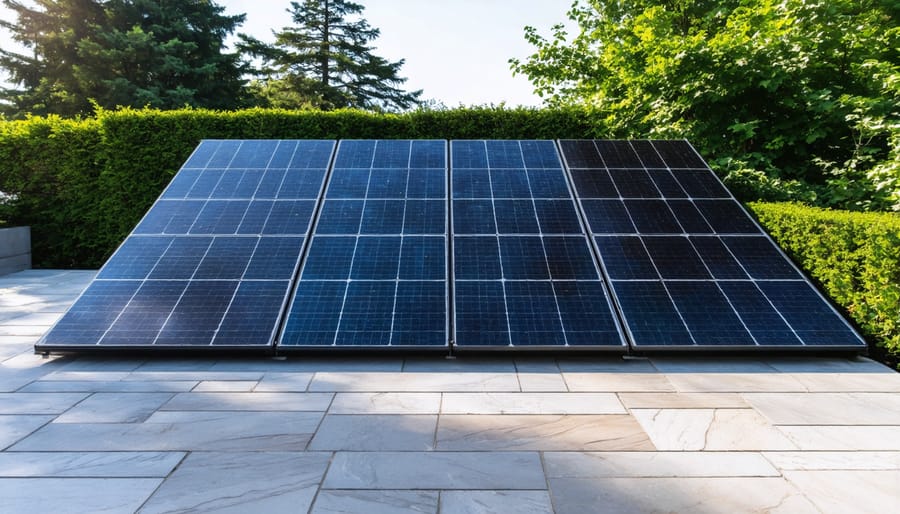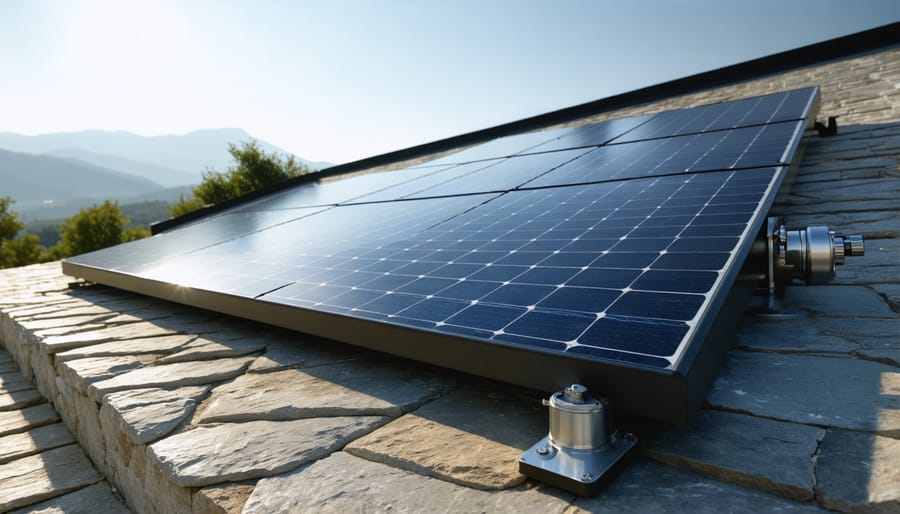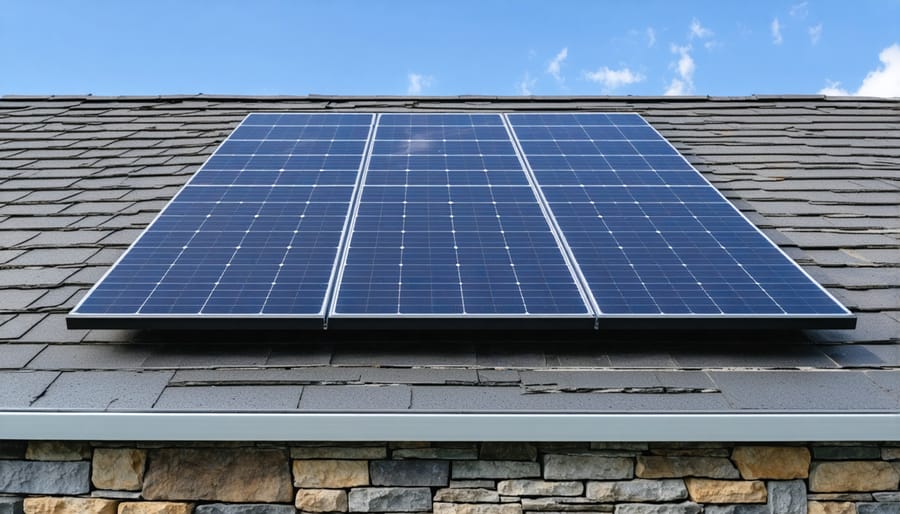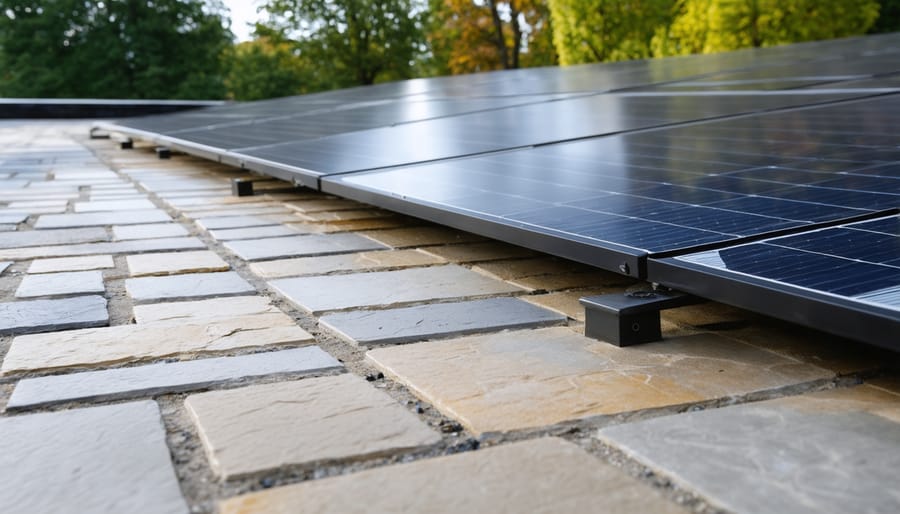Transform your outdoor space into a sustainable masterpiece by seamlessly blending solar technology with natural stone elements. The integration of photovoltaic systems into stone facades, pathways, and structural elements represents a groundbreaking advancement in sustainable architecture, offering both aesthetic appeal and practical energy generation.
Modern solar integration techniques have revolutionized how we approach stone construction, enabling homeowners and designers to maintain the timeless beauty of natural stone while harnessing clean energy. From solar-embedded granite countertops to limestone wall panels with integrated photovoltaic cells, these innovations are reshaping our understanding of sustainable building materials.
This fusion of ancient building materials with cutting-edge solar technology creates a perfect harmony between traditional architecture and renewable energy solutions. Whether you’re planning a new construction project or upgrading an existing stone installation, understanding the principles of solar integration can help you achieve both environmental efficiency and architectural excellence. The key lies in selecting compatible materials, proper planning, and expert implementation to ensure optimal energy generation while preserving the natural beauty of stone elements.
This comprehensive guide explores the latest techniques, materials, and design considerations for successfully merging solar technology with natural stone applications in residential and commercial settings.
Why Natural Stone and Solar Make Perfect Partners
Thermal Properties of Natural Stone
Natural stone’s inherent thermal mass benefits make it an excellent companion to solar installations. Stone’s ability to absorb, store, and gradually release heat creates a natural temperature regulation system that complements solar energy systems. During sunny periods, stone surfaces absorb excess heat, preventing immediate temperature spikes in interior spaces. As temperatures cool, the stored heat slowly dissipates, maintaining more consistent indoor comfort levels.
Different types of stone offer varying thermal properties. Dense stones like granite and slate typically provide superior heat retention compared to more porous varieties. This characteristic makes them particularly effective in solar passive design, where the stone works in harmony with solar panels to optimize energy efficiency. The thermal conductivity of natural stone also helps distribute heat evenly throughout spaces, reducing hot spots and improving overall system performance.
When properly integrated with solar installations, stone’s thermal properties can significantly reduce heating and cooling costs while extending the effectiveness of solar energy systems beyond direct sunlight hours.
Aesthetic Integration Benefits
The integration of solar panels with natural stone creates a harmonious blend of modern technology and timeless beauty. When thoughtfully designed, solar installations can actually enhance the visual appeal of stone surfaces rather than detract from them. Modern solar panels come in sleek, low-profile designs that can complement the natural textures and patterns of stone facades or pavers.
Color-matching has become increasingly sophisticated, with solar panels available in various hues that can be selected to coordinate with different stone types, from warm sandstone to cool granite. Some manufacturers even offer customizable panel frames that can match specific stone colorations, creating a seamless aesthetic transition.
The positioning of solar panels can be strategically planned to create interesting architectural features, such as floating arrays that cast artistic shadows on stone surfaces or integrated designs that follow the natural lines of stone walls. In contemporary architecture, this fusion of sustainable technology and natural materials often becomes a defining feature, demonstrating how traditional building materials can embrace modern energy solutions while maintaining their inherent beauty.

Planning Your Stone-Solar Integration Project
Assessing Your Stone Surface
Before integrating solar technology with your natural stone surfaces, a thorough assessment is essential to ensure compatibility and optimal performance. Begin by examining the physical characteristics of your stone, including its texture, porosity, and structural integrity. Different types of stone require specific stone installation techniques and may interact differently with solar components.
Consider the stone’s location and orientation, as these factors significantly impact solar efficiency. South-facing surfaces typically receive the most sunlight in the Northern Hemisphere, making them ideal candidates for solar integration. Evaluate any surrounding obstacles like trees or buildings that might cast shadows on your stone surface throughout the day.
Document the stone’s current condition, noting any cracks, chips, or signs of weathering. These imperfections must be addressed before installation to prevent future complications. Measure the available surface area carefully, accounting for any architectural features or existing fixtures that might affect placement.
Test the stone’s load-bearing capacity, as solar installations add considerable weight. If you’re uncertain about structural requirements, consult a professional engineer. Additionally, check local building codes and historic preservation guidelines that might impact your solar integration project. This preliminary assessment will help determine the most appropriate solar solution for your specific stone surface while maintaining both functionality and aesthetic appeal.
Choosing the Right Solar Solution
When selecting solar components for stone integration, several key factors must be considered to ensure optimal performance and aesthetic harmony. First, assess your stone surface’s orientation, angle, and exposure to sunlight throughout the day. South-facing surfaces typically receive the most sunlight in the Northern hemisphere, making them ideal candidates for solar integration.
Consider the weight-bearing capacity of your stone structure when choosing solar panels. Thin-film solar panels are lighter and more flexible than traditional crystalline panels, making them suitable for vertical stone walls or curved surfaces. However, crystalline panels offer higher efficiency in smaller spaces, perfect for limited stone surfaces.
The mounting system is crucial for successful integration. Choose corrosion-resistant brackets and fasteners specifically designed for stone surfaces. Some manufacturers offer specialized mounting solutions that minimize drilling into stone while ensuring secure attachment. Look for systems with adjustable mounting points to accommodate stone’s natural irregularities.
Color matching is another important consideration. Many solar manufacturers now offer panels in various colors and textures that can complement natural stone. Some even produce solar tiles that mimic stone patterns, allowing for seamless integration with existing stonework.
Finally, consider the system’s overall efficiency requirements. Calculate your energy needs and compare them with the available stone surface area to determine the most appropriate panel type and configuration. Working with a qualified solar installer who has experience with stone integration will help ensure the best possible outcome.
Installation Techniques and Best Practices
Mounting Systems for Natural Stone
When integrating solar panels with natural stone surfaces, selecting the appropriate mounting system is crucial for both structural integrity and aesthetic appeal. Several mounting options are available, each suited to different stone types and installation scenarios.
Penetrating anchor systems work well with dense stones like granite and quartzite, providing robust attachment points through pre-drilled holes. These systems require careful installation to prevent water infiltration and maintain the stone’s structural integrity. For softer stones like limestone or sandstone, distributed load mounting systems are preferred to avoid concentrated stress points.
Ballasted mounting systems offer a non-penetrating alternative, particularly suitable for flat stone surfaces. These systems use weight distribution to secure solar panels without drilling into the stone, making them ideal for historic properties or where stone preservation is paramount.
For vertical stone facades, specialized bracket systems can be employed. These brackets transfer loads directly to the building’s structural framework while maintaining proper spacing between the panels and stone surface for ventilation.
Custom-engineered mounting solutions may be necessary for unique stone applications or complex architectural features. These systems often combine multiple mounting techniques to achieve optimal performance while respecting the stone’s natural characteristics.
Each mounting system must account for the stone’s weight-bearing capacity, thermal expansion properties, and local climate conditions. Professional assessment is essential to determine the most suitable mounting solution for your specific stone application.

Preserving Stone Integrity
When integrating solar installations with natural stone, preserving the stone’s structural and aesthetic integrity is paramount. Begin by conducting a thorough assessment of the stone surface, noting any existing damage or vulnerable areas. Use non-abrasive cleaning methods to prepare the surface, avoiding harsh chemicals that could react with the stone’s mineral composition.
Install protective barriers between mounting hardware and stone surfaces to prevent direct contact. These barriers, typically made of high-grade rubber or specialized mounting pads, help distribute weight evenly and prevent moisture accumulation. For vertical installations, ensure proper spacing between the stone and solar panels to allow adequate airflow and prevent heat buildup.
During drilling or anchoring processes, use appropriate masonry bits and techniques specific to the stone type. Diamond-tipped bits at low speeds help prevent cracking or spalling. Always mark drilling points carefully and maintain consistent depth to ensure uniform installation while minimizing structural impact.
Consider implementing a moisture management system to prevent water from becoming trapped between solar equipment and stone surfaces. This might include proper flashing installation and strategic placement of weep holes. Regular inspections of mounting points and surrounding stone areas help identify potential issues before they become significant problems.
Finally, document all installation points and methods used for future reference and maintenance purposes. This information proves invaluable for long-term stone preservation and system modifications.
Wiring and Connection Solutions
When integrating solar components with natural stone features, proper wiring and connection solutions are crucial for both safety and functionality. The key is to plan concealed pathways for electrical conduits that don’t compromise the stone’s structural integrity or aesthetic appeal.
For stone walls and facades, create dedicated channels or cavities during the construction phase to accommodate wiring. These pathways should be lined with appropriate conduit material to protect cables from moisture and mechanical damage. Consider installing junction boxes at strategic locations, preferably behind removable stone panels for easy access during maintenance.
Solar micro-inverters and power optimizers can be mounted on bracketing systems that attach to the stone surface while maintaining proper airflow. Use waterproof cable management systems and UV-resistant materials specifically designed for outdoor applications. All connections should be properly sealed and weatherproofed to prevent water infiltration.
When working with existing stone structures, minimize intrusive drilling by utilizing natural joints and seams where possible. Surface-mounted raceways can be color-matched to blend with the stone’s appearance. For ground-mounted systems near stone features, underground conduit should be installed at appropriate depths and clearly marked to prevent future excavation damage.
Always consult local building codes and hire certified electrical professionals for installation. Proper documentation of wiring layouts will prove invaluable for future maintenance and modifications.

Maintenance and Long-term Care
Regular Maintenance Schedule
To maintain optimal performance of your solar-integrated stone installation, follow this quarterly and annual maintenance schedule. Every three months, inspect the solar panels for dust, debris, and bird droppings, gently cleaning them with non-abrasive materials and specialized solar panel cleaners. Check the stone surfaces for any signs of weathering or discoloration, particularly around mounting points.
Annually, schedule a professional inspection of both the solar system and stone elements. This should include testing of all electrical connections, verification of panel efficiency, and assessment of the mounting system’s integrity. Examine sealants and weather barriers between panels and stone surfaces, replacing as needed. Clean gutters and drainage systems to prevent water accumulation that could affect both components.
During spring and fall, pay special attention to gaps between panels and stone surfaces, ensuring they remain clear of leaves and organic matter. After severe weather events, conduct additional inspections to check for any damage or loose components. Keep detailed maintenance records, including cleaning dates, efficiency readings, and any repairs, to track system performance and predict future maintenance needs.
Remember to update your maintenance schedule based on local climate conditions and specific installation requirements.
Troubleshooting Common Issues
When integrating solar panels with natural stone, several common issues may arise. Poor water drainage can lead to moisture accumulation between panels and stone surfaces, potentially causing discoloration or structural damage. Address this by ensuring proper flashing installation and maintaining adequate spacing between panels and stone surfaces.
Thermal expansion differences between stone and mounting hardware can create stress points. Use flexible mounting systems designed to accommodate movement and ensure proper spacing between components. If cracks appear, consult a professional immediately to prevent further damage.
Aesthetic misalignment often occurs when panels are installed without considering the stone’s natural patterns. Solve this by carefully planning panel placement during the design phase and using adjustable mounting systems that allow for precise positioning.
Installation challenges may include difficulty drilling into dense stone materials. Always use appropriate diamond-tipped bits and follow manufacturer guidelines for anchor placement. If you encounter unusually hard sections, consult with a stone specialist to identify alternative mounting locations.
For existing installations experiencing efficiency issues, check for dust accumulation in gaps between panels and stone surfaces. Regular cleaning and maintenance will help maintain optimal performance while preserving the stone’s integrity.
The integration of solar technology with natural stone represents a remarkable fusion of sustainable energy and timeless architecture. Throughout this guide, we’ve explored how these two elements can work together harmoniously, creating both aesthetically pleasing and environmentally conscious spaces. From selecting compatible stone materials to understanding mounting techniques and maintaining optimal performance, the possibilities for combining solar solutions with natural stone are extensive and exciting.
Remember that successful integration requires careful planning, professional consultation, and consideration of various factors including local regulations, structural requirements, and aesthetic preferences. The investment in combining solar technology with natural stone can significantly enhance your property’s value while reducing energy costs and environmental impact.
Whether you’re considering solar panels for a stone-clad facade, integrating solar tiles with existing stonework, or planning a completely new installation, the key is to balance functionality with design. By working with qualified professionals and following proper installation guidelines, you can create a sophisticated, sustainable solution that preserves the natural beauty of stone while harnessing clean energy.
As sustainable building practices continue to evolve, the marriage of solar technology and natural stone stands as a testament to how traditional materials can adapt to modern energy needs. Take the first step toward your stone-solar integration project today and join the growing movement toward beautiful, sustainable architecture.










